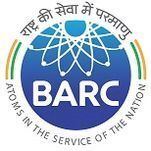Abbreviation BARC Purpose Nuclear research Director K.N. Vyas | Legal status Operational Location India Founded 3 January 1954 | |
 | ||
Formation January 3, 1954 (1954-01-03) Budget 31.59 billion INR (2015–2016) Motto Atoms in the service of the Nation | ||
Pm narendra modi visits bhabha atomic research centre
The Bhabha Atomic Research Centre (BARC) is India's premier nuclear research facility based in Trombay, Mumbai, Maharashtra. BARC is a multi-disciplinary research centre with extensive infrastructure for advanced research and development covering the entire spectrum of nuclear science, engineering and related areas.
Contents
- Pm narendra modi visits bhabha atomic research centre
- Farewell tso s of 57th batch bhabha atomic research centre
- History
- India and the NPT
- Civilian research
- References
BARC's core mandate is to sustain peaceful applications of nuclear energy, primarily for power generation. It manages all facets of nuclear power generation, from theoretical design of reactors, computerised modelling and simulation, risk analysis, development and testing of new reactor fuel materials, etc. It also conducts research in spent fuel processing, and safe disposal of nuclear waste. Its other research focus areas are applications for isotopes in industries, medicine, agriculture, etc. BARC operates a number of research reactors across the country.
Farewell tso s of 57th batch bhabha atomic research centre
History
The Government of India created the Atomic Energy Establishment, Trombay (AEET) on 3 January 1954. It was established to consolidate all the research and development activity for nuclear reactors and technology under the Atomic Energy Commission. All scientists and engineers engaged in the fields of reactor design and development, instrumentation, metallurgy and material science etc. were transferred with their respective programmes from the Tata Institute of Fundamental Research (TIFR) to AEET, with TIFR retaining its original focus for fundamental research in the sciences. After Homi J. Bhabha's death in 1966, the centre was renamed as the Bhabha Atomic Research Centre on 22 January 1967. All the directors of the BARC were highly qualified doctorates in their discipline and were internationally recognised for their contribution in academia, who were the crown of this prestigious research organisation.
The first reactors at BARC and its affiliated power generation centres were imported from the west. India's first power reactors, installed at the Tarapur Atomic Power Station were from the United States.
The primary importance of BARC is as a research centre. The BARC and the Indian government has consistently maintained that the reactors are used for this purpose only: Apsara (1956; named by the then Prime Minister of India, Jawaharlal Nehru when he likened the blue Cerenkov radiation to the beauty of the Apsaras), CIRUS (1960; the "Canada-India Reactor" with assistance from the US), the now-defunct ZERLINA (1961; Zero Energy Reactor for Lattice Investigations and Neutron Assay), Purnima I (1972), Purnima II (1984), Dhruva (1985), Purnima III (1990), and KAMINI.
The plutonium used in India's 1974 Smiling Buddha nuclear test came from CIRUS. The 1974 test (and the 1998 tests that followed) gave Indian scientists the technological know-how and confidence not only to develop nuclear fuel for future reactors to be used in power generation and research, but also the capacity to refine the same fuel into weapons-grade fuel to be used in the development of nuclear weapons.
BARC also designed and built India's first Pressurised water reactor at Kalpakkam, a 80MW land based prototype of INS Arihant's nuclear power unit, as well as the Arihant's propulsion reactor.
India and the NPT
India is not a part of the Nuclear Non-Proliferation Treaty (NPT), citing concerns that it unfairly favours the established nuclear powers, and provides no provision for complete nuclear disarmament. Indian officials argued that India's refusal to sign the treaty stemmed from its fundamentally discriminatory character; the treaty places restrictions on the non-nuclear weapons states but does little to curb the modernisation and expansion of the nuclear arsenals of the nuclear weapons states.
More recently, India and the United States signed an agreement to enhance nuclear cooperation between the two countries, and for India to participate in an international consortium on fusion research, ITER (International Thermonuclear Experimental Reactor) so there are signs that the west wants to bring India in the Nuclear mainstream.
Civilian research
The BARC also conducts research in biotechnology at the Gamma Gardens, and has developed numerous disease resistant and high-yielding crop varieties, particularly groundnuts. It also conducts research in Liquid Metal Magnetohydrodynamics for power generation.
On 4 June 2005, with the goal of encouraging research in basic sciences, BARC started the Homi Bhabha National Institute. Research institutions affiliated to BARC(Bhabha Atomic Research Centre) include IGCAR (Indira Gandhi Centre for Atomic Research), RRCAT (Raja Ramanna Centre for Advanced Technology), and VECC (Variable Energy Cyclotron Centre).
Power projects that have benefited from BARC expertise but which fall under the NPCIL (Nuclear Power Corporation of India Limited) are KAPP (Kakrapar Atomic Power Project), RAPP (Rajasthan Atomic Power Project), and TAPP (Tarapur Atomic Power Project).
The Bhabha Atomic Research Centre in addition to its nuclear research mandate, also conducts research in other high technology areas like accelerators, micro electron beams, materials design, supercomputers, computer vision among the few. The BARC has dedicated departments for these specialised fields. BARC has designed and developed, for its own use an infrastructure of supercomputers, Anupam using state of the art technology.
